This first table shows the HX-CU1020V’s Watts/10 Delta Temp numbers in a quick glance chart format.
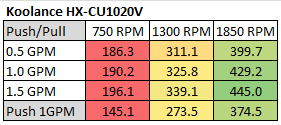
Using the data compiled from the thermal testing I have compiled the following tables in an attempt to show other ways of how the CUV’s performance varies against itself at the flow rates and fan speeds tested. Effectively these show percentage gains relative to a reference point. It’s an interesting way to show gains/losses while changing a variable.
First let’s focus on 1300 RPM as our reference and see how much gain or loss in performance we get by changing fan speed.
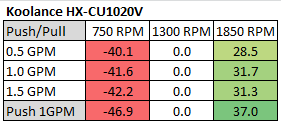 Very large differences here indicate this rad is tuned for best performance with high speed fans.
Very large differences here indicate this rad is tuned for best performance with high speed fans.
In the next plot we focus on changing the flow rate with 1.0 GPM as the base line.
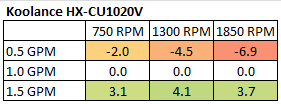 With only slight percentage variations when changing the flow rate we conclude that flow rate is not a determining factor for performance on the HX-CU1020V.
With only slight percentage variations when changing the flow rate we conclude that flow rate is not a determining factor for performance on the HX-CU1020V.
Let’s combine both flow rate and fan speed as reference points and have a look at 0.5 GPM & 750 RPM as the reference point.
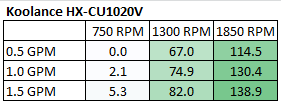 This confirms what we speculated above, as here we see a big boost from 750rpm to 1300rpm at 0.5 gpm showing weak low fan speed performance and we also see very small gains in the 750rpm column with increased flow rate.
This confirms what we speculated above, as here we see a big boost from 750rpm to 1300rpm at 0.5 gpm showing weak low fan speed performance and we also see very small gains in the 750rpm column with increased flow rate.
Lastly, we change the reference and choose our center 1300 RPM and 1.0 GPM as our reference point to show both effects concurrently:
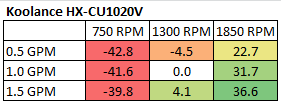
So from the data above we can get a very good idea of how the CUV radiator performs relative to itself. But there is a large selection of 360mm radiator models to choose from, released from numerous manufacturers. So, we need to start comparing performance between them.
Push Only Data vs Competition
Let’s focus on the Push Only results for now and come back to the Push/Pull data later. While for Push/Pull we tested three flow rates, the Push Only testing was conducted only at 1GPM in order to save time. For a comparison vs thicker radiators make sure to check out the 2015 Rad Round Up which compares 28+ radiators including the CUV.
Let’s start with 750 RPM and see how it compares to the competition:
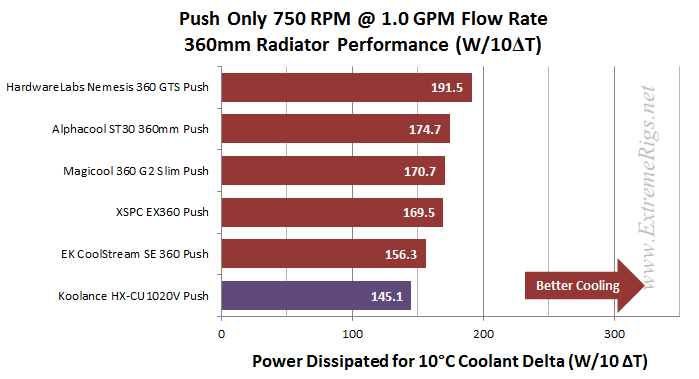 The CUV places last in the low speed Push Only rankings with performance a whopping 24% behind the winner. Not a surprising result given the core design, but still, that is quite some margin.
The CUV places last in the low speed Push Only rankings with performance a whopping 24% behind the winner. Not a surprising result given the core design, but still, that is quite some margin.
Now let’s look at 1300 rpm:
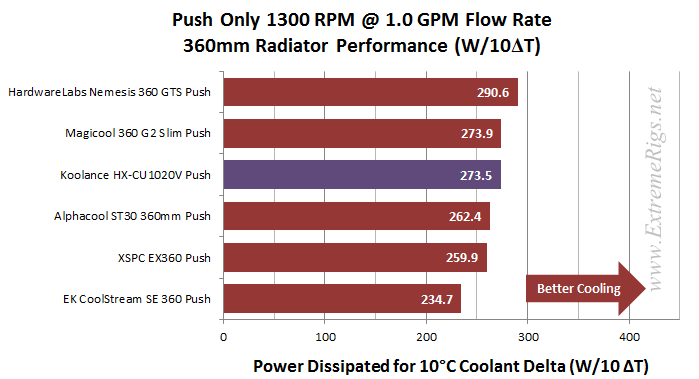 The CUV does quite well now – 3rd place (just) and only ~6% behind the leader.
The CUV does quite well now – 3rd place (just) and only ~6% behind the leader.
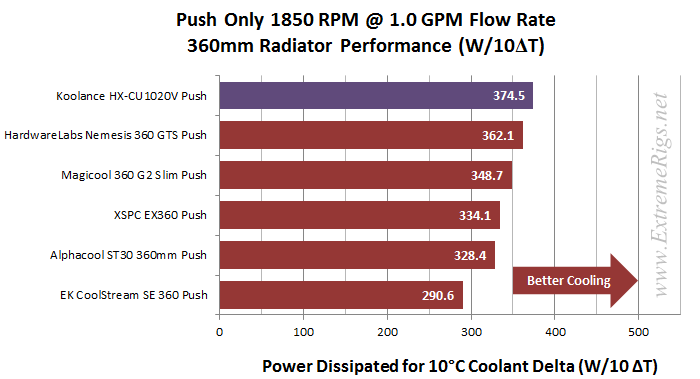 At 1850 Push Only the CUV’s dense core structure has gained the performance advantage and taken 1st place.
At 1850 Push Only the CUV’s dense core structure has gained the performance advantage and taken 1st place.
So as expected the CUV was a poor performer in Push Only with low fan speeds, but really came into its performance zone as we increased the fan speed. We expect the same trend to continue with the Push/Pull results.
Push/Pull Data vs. Competition
Let’s now look at the Push/Pull results and see how the CUV 360 compares. For Push/Pull we have averaged the results from the 3 flow rates at which we tested.
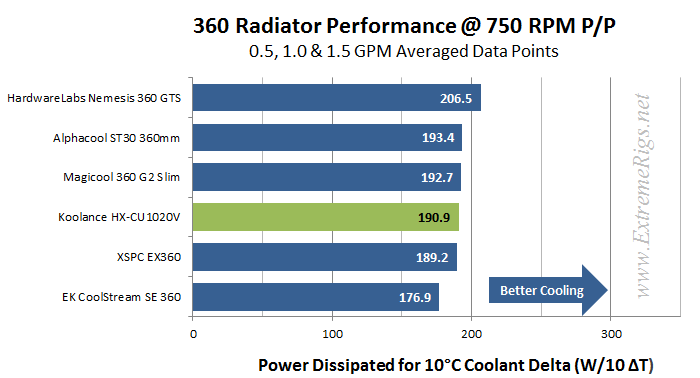 The CUV placed 4th in the low speed Push/Pull. Here we can see a clear winner and a clear loser with the 4 others tightly grouped in the middle.
The CUV placed 4th in the low speed Push/Pull. Here we can see a clear winner and a clear loser with the 4 others tightly grouped in the middle.
Let’s move to 1300 rpm:
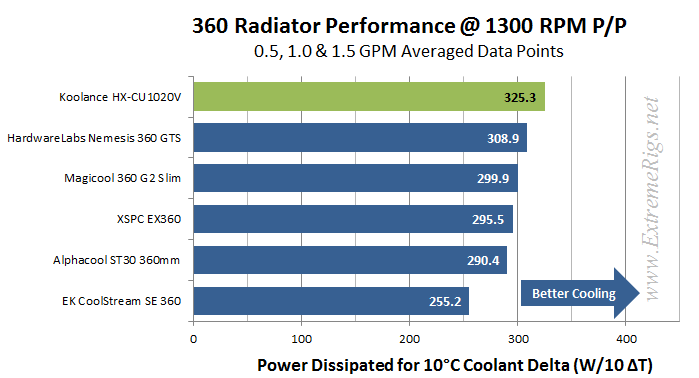 At 1300 the CUV takes a clear lead over the rest and has ~5% performance advantage of the second place rad.
At 1300 the CUV takes a clear lead over the rest and has ~5% performance advantage of the second place rad.
Now 1850RPM:
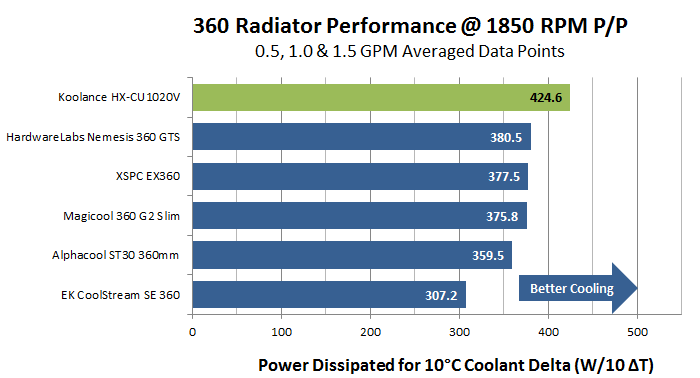
At 1850 Push/Pull the CUV 360 is just getting wound up and is the clear winner of this data point. Unfortunately we can go no higher with fan speeds in this test.
So the CUV 360 placed 1st in all 3 of the 6 categories. It has excellent high speed fan performance while has rather weak slow fan speed results. This is of course expected and is due to the dense fin structure.
Now let’s also combine the Push Only and Push/Pull results at the 1.0 GPM flow rate into one plot for each fan speed tested. This gets confusing quickly so the results are color coded for easier viewing.
Again let’s start with the 750 rpm first:
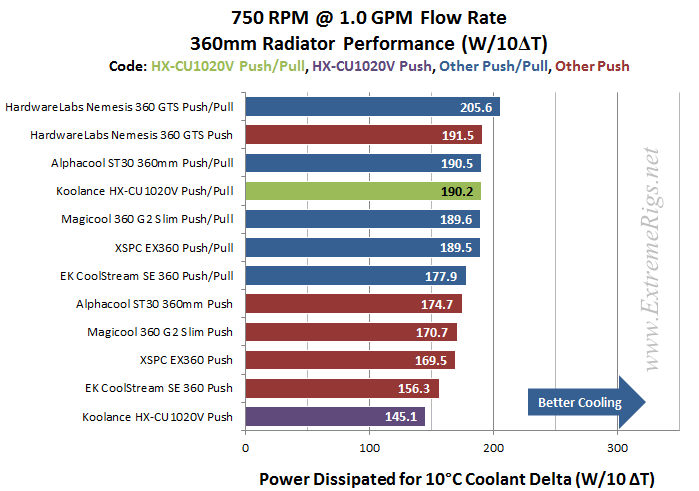 We are of course just repeating data here in a combined plot format, but it can sometimes be useful in helping to decide if Push Only or Push/Pull fan assemblies may be of more benefit for certain installations, and which rad to choose over another.
We are of course just repeating data here in a combined plot format, but it can sometimes be useful in helping to decide if Push Only or Push/Pull fan assemblies may be of more benefit for certain installations, and which rad to choose over another.
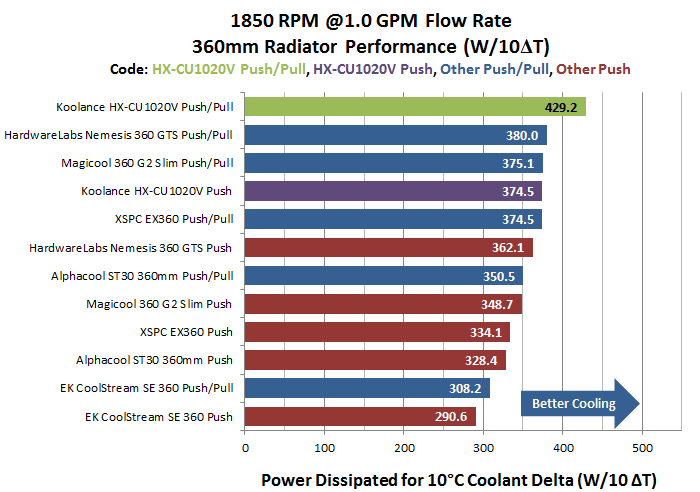
From all of test results we created “Average Performance Factor” charts for both Push and Push/Pull and then a combined plot called the “Master Performance Factor”. The radiator with the best cooling ability (W/10ΔT) at each gpm/rpm combo was awarded a score of 100, and each other radiators W/10ΔT result was scored as percentage of the top performer.
This way of looking at the comparison takes away any advantages that a radiator may have at higher or lower fan speeds and looks at an overall average. While this appears fair it does tend to favor those radiators that are all-rounders and those radiators which do very well at high RPM. Most users should be more focused on their specific use case. Check in the Round Up for performance comparisons at every gpm/rpm combo for even more details and cross comparison results.
Here is the HX-CU1020V’s Push/Pull percentage scores at each data point that thermal tests were conducted at and additionally the 1.0 gpm Push Only percentages relative to the winner at each fan speed.
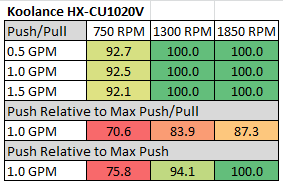
This show the dominance of the CUV at medium and high speed fans in Push Pull. Flow rate did not affect its comparison performance results, placing 1st at each flow rate for these fan speeds.
Then we started averaging the percentage scores at each flow rate giving us the Averaged Performance Factors (APF) of each radiator.
Firstly – the Push Only APF:
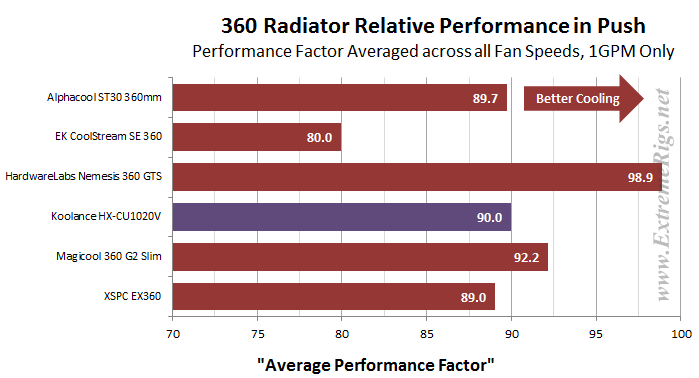 While placing 1st in the Push Only high speed fan test, the very weak low fan speed result really dragged down its average score.
While placing 1st in the Push Only high speed fan test, the very weak low fan speed result really dragged down its average score.
Now the Push/Pull APF:
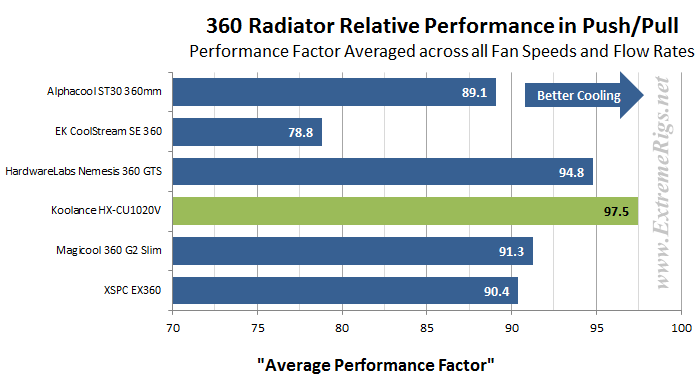 The great results in Push/Pull with medium and high speed fans boosted the CUV into top spot.
The great results in Push/Pull with medium and high speed fans boosted the CUV into top spot.
Finally the Master Performance Factor which is calculated from the averaged results of all the thermal tests, Push and Push/Pull at all flow rates and all fan speeds.
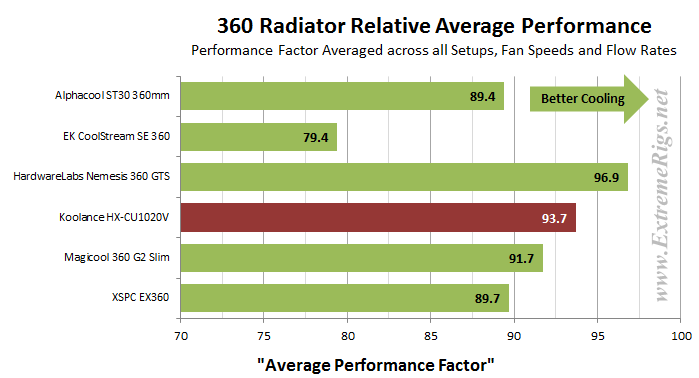 In the Master Performance Factor comparisons the HX-CU1020V 360mm finishes in second place. The core design is very biased towards the higher static pressure of Push/Pull fan assemblies. The great all round performance of the GTS radiator really did earn the top spot.
In the Master Performance Factor comparisons the HX-CU1020V 360mm finishes in second place. The core design is very biased towards the higher static pressure of Push/Pull fan assemblies. The great all round performance of the GTS radiator really did earn the top spot.
Next up – Summary!








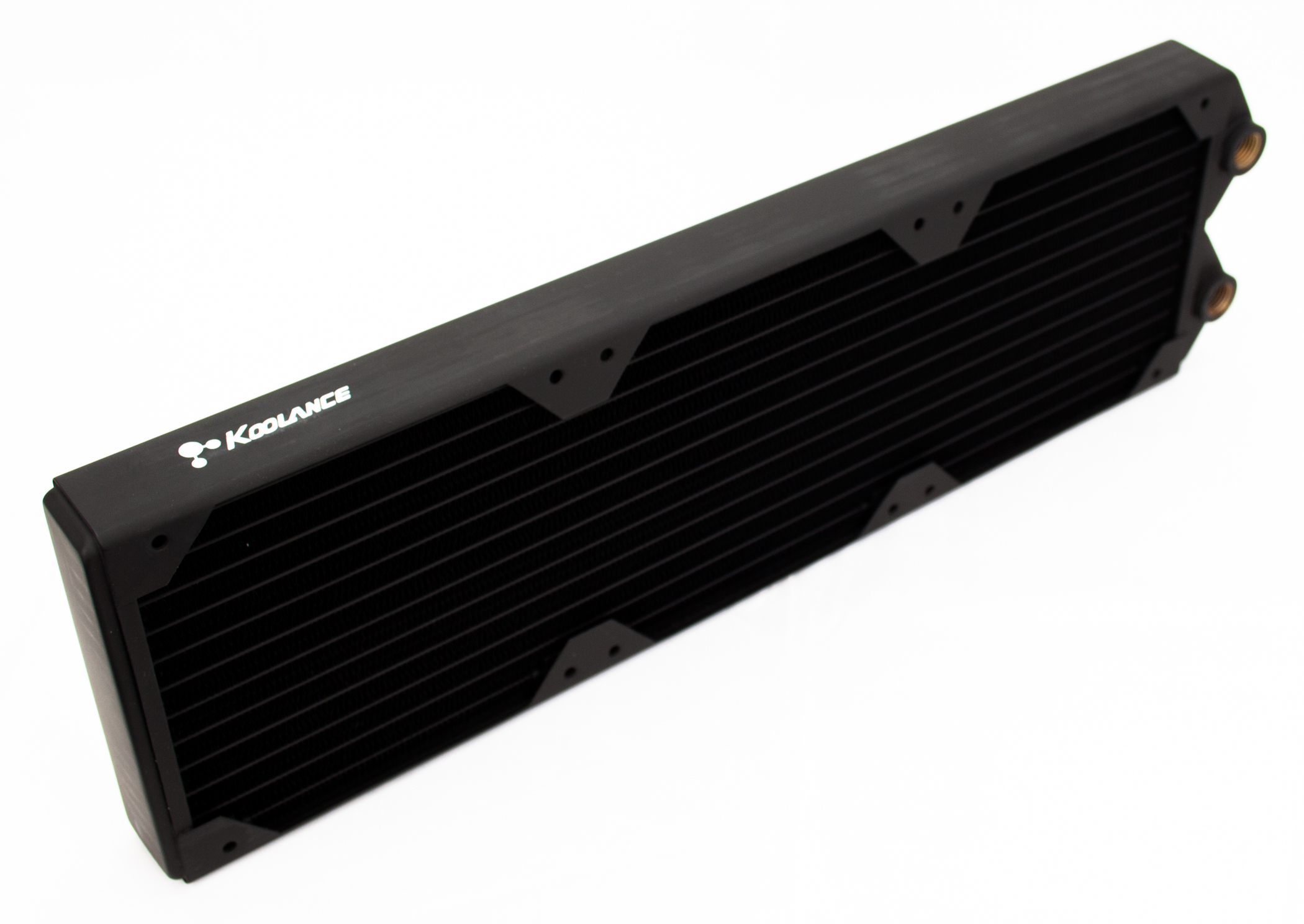
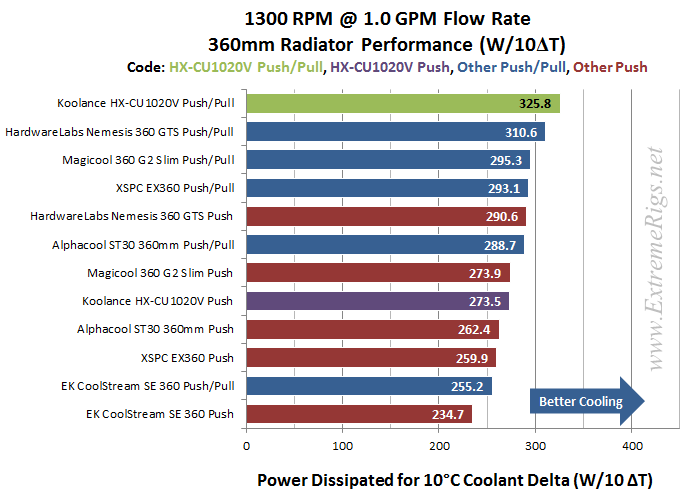



Okay, so this is the antithesis of the Nemesis GTS: great at push pull high speeds, were as the Nemesis GTS is king of push only low / medium speeds. Glad I got two Nemesis GTS for my build.
As always, thank you for the great review and additional data to the radiator database.
[…] Koolance HX-CU1020V 360mm Radiator Review […]
Your overall score lacks the scrutiny and precision that you have applied to your superb test and measurement criteria.
The feature set (extra ports, etc.) and paint finish have no bearing on thermal performance and when this low marking for ‘features & quality’ is applied as a major constituent of the overall summary score this excellent radiator immediately looks second rate to the casual reader and beginner in the field of water-cooling.
Many people who visit your site will not read or necessarily understand your entire review or the graphs which look at factors outside the original design spec for this radiator, i.e. it was not really intended to be used with low speed fans, hence the high fin density. Also most enthusiast and professional builders will be using a push/pull design, high static pressure fans and, spacing permitting, shrouds to reduce the ‘dead spot’ created by 120mm fan centre hubs ( or 140mm based radiators)
You write for a site called extremerigs not ‘boy racer add-ons’ and although I do not dispute the fairness and balance within your text, other than the over-emphasis on “extreme restriction” which is easily overcome, your final score is misleading. I am not suggesting that you are being specifically unfair to Koolance, but in my standing as a Senior Design Engineer in many fields of engineering for the past 24 years, your scoring puts too much emphasis on the non-essential.
As an enthusiast, I have built 80+ water-cooled rigs since 2003, three of them with large industrial grade heat exchangers (peltier based) running coolant down to -55 Celsius. Most people cannot afford or be bothered with the complexity of ‘chilled’ systems, but multiple radiator systems have become increasingly popular over the past decade. I have used multiple units of this excellent radiator and its thicker ‘big brother’ in more than 30 builds and various HW Labs Black Ice variants in around 20 builds with complex Quad SLI configurations without any issues or compromise!
Unfortunately, over the past 3 years the market has become flooded with flashy ‘boy racer’ radiators which may look impressive and have many extra features, but in what ways do these improve cooling performance?
Many of these features are about as useful as the range of ‘viewing windows’ which were being sold for HDs and PSUs until the worldwide economic crisis hit. I do not dispute that some features make the design process easier when deciding the route for tubing to water-blocks and manifolds, but adding a ‘universal’ feature set to every radiator design will add unnecessary cost.
Comments are closed.